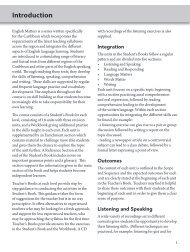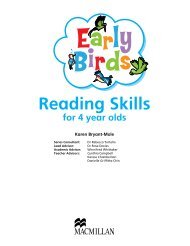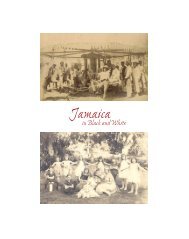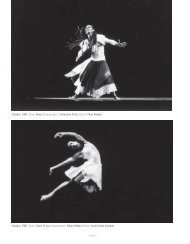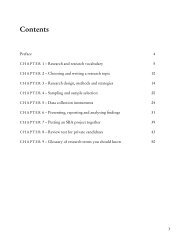Curry, Callaloo & Calypso - Macmillan Caribbean
Curry, Callaloo & Calypso - Macmillan Caribbean
Curry, Callaloo & Calypso - Macmillan Caribbean
Create successful ePaper yourself
Turn your PDF publications into a flip-book with our unique Google optimized e-Paper software.
The Indians made their rotis on a tavah (tawah), or baking stone, over the chulla. They roasted<br />
vegetables to make chokas, ground peas for fritters, and preserved fruits such as mango for<br />
kutchela and amchar to ensure there was a constant supply of hot and sour condiments to<br />
accent their meals. They deep-fried small rotis known as ‘pooris’; today we enjoy the same but<br />
we call them fried bakes. The rotis they cooked when they came were chapattis and parathas;<br />
the chapattis are now known as sada roti, the paratha has remained much the same. Through<br />
the years, they introduced the dhalpouri roti or split pea stuffed roti.<br />
The immigrant Indians improvised in the kitchen to produce foods that were close to those<br />
of their motherland. This improvisation resulted in our local East Indian foods: Indian delicacies,<br />
flaky rotis, curries, condiments, vegetables and sweets, specific only to the <strong>Caribbean</strong>.<br />
At the end of their indenture-ship period the Indians were given the choice of returning to<br />
India or remaining in Trinidad, where they were given the option to purchase land. Those that<br />
chose to stay purchased lands and either remained in the sugar industry or went into farming<br />
cocoa and coconuts on their own estates. Those that embraced cooking started to sell roti in the<br />
parlours. Those roti parlours have become a part of our ‘fast food’ empire here in Trinidad and<br />
are known as roti shops. Others chose to sell ‘doubles’ from bicycles with carts attached. These<br />
have become a national culinary institution, and today doubles vendors can be found all over<br />
the country at varying times of day.<br />
After the Indians came many other settlers, such as the Syrians and more Europeans. They too<br />
have tried to preserve the foods of their homelands and these influences are noted in our cuisine<br />
as well.<br />
Today many of our culinary customs are still observed and some of the methods that have<br />
been described here are still preserved in our rural areas. The foods that we now enjoy are a<br />
direct result of a fusion of those influences left to us by our forefathers. When we talk about the<br />
cuisine of Trinidad and Tobago, it is Indian and Creole foods which top the list of rich inherited<br />
dishes; both form the foundation of our national culinary landscape. These are the foods that<br />
have indeed etched a place for Trinidad and Tobago on the world culinary map.<br />
Modern-day chulla<br />
17<br />
9780230038578.indd 17 25/07/2011 13:08



